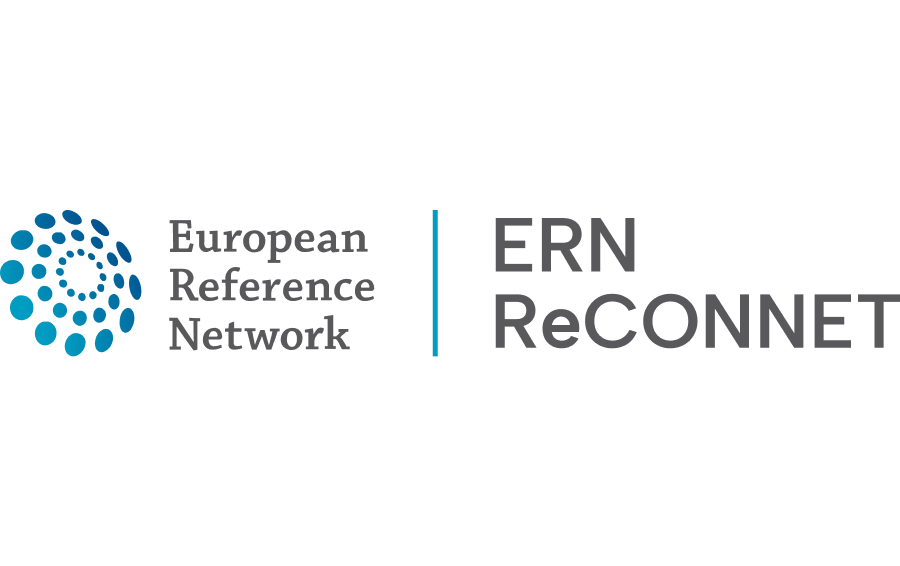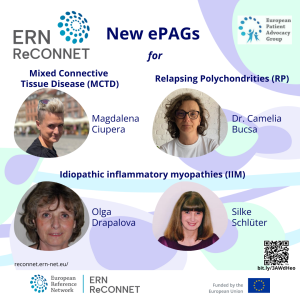ERN ReCONNET
Disease Info
Disease: Relapsing Polychondritis
Relapsing Polychondritis (RP)
What is RP?
Clinical overview of the disease
Relapsing polychondritis (RP) is a clinically heterogeneous, multisystemic inflammatory disease characterized by inflammation of the cartilage and proteoglycan rich structures (connective tissue) leading to cartilage damage along with joint, ENT, pulmonal and cardiovascular involvement. It may cause damage of affected structures that might lead to organ failure, is rarely life-threatening and very rarely a cause of life-threatening symptoms.
Epidemiology
RP is a very rare disease with an estimated prevalence of 9/1,000,000 and an incidence of 0.7/1,000,000/year (UK). It is not restricted in age or sex but mainly affects midle age persons.
Risk factors and possible causes
The cause of RP is not known but it shows features of autoinflammation, autoimmunity and granuloma formation. The risk of inheritance is not proofed yet but very few familiar cases have been reported. Aside a primary RP, the clinical manifestation is seen as secondary disease in other autoimmune diseases like Rheumatoid Arthritis, Systemic Lupus Erythematodes, Sjögrens Syndrome or Hashimoto’s thyreoiditis. A secondary disease might be the first clinical sign in hematologic diseases like VEXAS Syndrome or Lymphoma. Overlapping features exist with Granulomatosis with polyangiitis and Behcet’s disease.
Common symptoms
Symptoms (and their reported frequency) are:
- Ear chondritis (>90%)
- Musculoskelettal symptoms (50-75%)
- Chondritis of nose and upper airways with hoarse voice or stridor (50-65%),
- Inflammation of the eye (50%)
- Chondritis of lower airways with breathlessness on exercise (30%)
- Common sickness (20%)
- Inflammation of vessels and heart valvues (10-20%)
- Skin inflammation (10%)
When to see a doctor?
In undiagnosed RP the symptoms are usually impressive resulting in an urgent contact to the family doctor with referral to a specialist like otolaryngologist, pulmonologist, ophthalmologist, cardiologist, dermatologist, or rheumatologist. In established disease red flags or unexpected symptoms should lead to a referral.
Diagnosis (path/tests/differential diagnosis)
There is no single blood or imaging test that can be used to diagnose RP. The diagnosis is mainly retrospective and based upon a combination of (remitting/relapsing) clinical presentations like bilateral auricular chondritis, inflammatory polyarthritis, nasal chondritis, ocular inflammation, respiratory tract chondritis and audiovestibular damage. Differential diagnosis are infections and other autoimmune diseases.
Treatments overview
There is no established standard therapy for RP. Treatment is based upon symptomatic therapy, prevention, both or even none. A healing is not to be expected. The natural course of the disease allows flares, remissions, relapse, chronic inflammation and damage. Symptomatic therapy could be based on non-steroidal anti-inflammatory drugs (e.g. Ibuprofene), steroids (cortisone) ond/or physiotherapy. Long term flare prevention is described with Colchicine, Dapsone, Methotrexate, and Biologicals (anti TNF, anti IL-1, …).
Prognosis
The majority of RP patients will present with a moderate severity, 10% with a benign and 5% with a refractory disease. The prognosis of secondary RP e.g. in VEXAS depends on the course of the underlying disease.
Clinical overview of the disease
Laurent Arnaud
Laurent Arnaud
Disease Coordinator
Disease Coordinator
Simona Rednic
Simona Rednic
Disease Coordinator
Disease Coordinator
ERN ReCONNET publications are available for consultation.
LIST OF USEFUL REFERENCES
1. Relapsing polychondritis: A clinical update
Longo L, Greco A, Rea A, Lo Vasco VR, De Virgilio A, De Vincentiis M.
Autoimmun Rev. 2016 Jun;15(6):539-43.
Longo L, Greco A, Rea A, Lo Vasco VR, De Virgilio A, De Vincentiis M.
Autoimmun Rev. 2016 Jun;15(6):539-43.
3. Pathogenesis of relapsing polychondritis: a 2013 update
Arnaud L, Mathian A, Haroche J, Gorochov G, Amoura Z.
Autoimmun Rev. 2014 Feb;13(2):90-5
4. Antibodies to type II collagen in relapsing polychondritis
Foidart JM, Abe S, Martin GR, Zizic TM, Barnett EV, Lawley TJ, Katz SI.
N Engl J Med. 1978 Nov 30;299(22):1203-7.
5. The occurrence of autoantibodies to matrilin 1 reflects a tissue-specific response to cartilage of the respiratory tract in patients with relapsing polychondritis
Hansson AS, Heinegård D, Piette JC, Burkhardt H, Holmdahl R.
Arthritis Rheum. 2001 Oct;44(10):2402-12.
Arnaud L, Mathian A, Haroche J, Gorochov G, Amoura Z.
Autoimmun Rev. 2014 Feb;13(2):90-5
Foidart JM, Abe S, Martin GR, Zizic TM, Barnett EV, Lawley TJ, Katz SI.
N Engl J Med. 1978 Nov 30;299(22):1203-7.
Hansson AS, Heinegård D, Piette JC, Burkhardt H, Holmdahl R.
Arthritis Rheum. 2001 Oct;44(10):2402-12.
6. Relapsing polychondritis. Survival and predictive role of early disease manifestations
Michet CJ Jr, McKenna CH, Luthra HS, O’Fallon WM.
Ann Intern Med. 1986 Jan;104(1):74-8.
7. Relapsing polychondritis – report of ten cases
Damiani JM, Levine HL.
Laryngoscope. 1979 Jun;89(6 Pt 1):929-46.
8. Utility of fluorodeoxyglucose positron emission tomography/computed tomography for early diagnosis and evaluation of disease activity of relapsing polychondritis: a case series and literature review
Yamashita H, Takahashi H, Kubota K, Ueda Y, Ozaki T, Yorifuji H, Bannai E, Minamimoto R, Morooka M, Miyata Y, Okasaki M, Takahashi Y, Kaneko H, Kano T, Mimori A.
Rheumatology (Oxford). 2014 Aug;53(8):1482-90.
9. Relapsing Polychondritis Can Be Characterized by Three Different Clinical Phenotypes: Analysis of a Recent Series of 142 Patients
Dion J, Costedoat-Chalumeau N, Sène D, Cohen-Bittan J, Leroux G, Dion C, Francès C, Piette JC.
Arthritis Rheumatol. 2016 Dec;68(12):2992-3001. doi: 10.1002/art.39790.
10. Aortic involvement in relapsing polychondritis
Le Besnerais M, Arnaud L, Boutémy J, Bienvenu B, Lévesque H, Amoura Z, Marie I.
Joint Bone Spine. 2018 May;85(3):345-351.
Michet CJ Jr, McKenna CH, Luthra HS, O’Fallon WM.
Ann Intern Med. 1986 Jan;104(1):74-8.
Damiani JM, Levine HL.
Laryngoscope. 1979 Jun;89(6 Pt 1):929-46.
Yamashita H, Takahashi H, Kubota K, Ueda Y, Ozaki T, Yorifuji H, Bannai E, Minamimoto R, Morooka M, Miyata Y, Okasaki M, Takahashi Y, Kaneko H, Kano T, Mimori A.
Rheumatology (Oxford). 2014 Aug;53(8):1482-90.
Dion J, Costedoat-Chalumeau N, Sène D, Cohen-Bittan J, Leroux G, Dion C, Francès C, Piette JC.
Arthritis Rheumatol. 2016 Dec;68(12):2992-3001. doi: 10.1002/art.39790.
Le Besnerais M, Arnaud L, Boutémy J, Bienvenu B, Lévesque H, Amoura Z, Marie I.
Joint Bone Spine. 2018 May;85(3):345-351.
Treatment of relapsing polychondritis: a systematic review
Petitdemange A, Sztejkowski C, Damian L, Martin T, Mouthon L, Amoura Z, Cutolo M, Burmester GR, Fonseca JE, Rednic S, Arnaud L.
Clin Exp Rheumatol. 2022 May;40 Suppl 134(5):81-85.
The relapsing polychondritis damage index (RPDAM): Development of a disease-specific damage score for relapsing polychondritis
Mertz P, Belot A, Cervera R, Chuah TY, Dagna L, Damian L, Danda D, D’cruz D, Espinosa G, Frances C, Jayne D, Ooi KK, Kucharz EJ, Lebovics R, Marie I, Moulis G, Peng S, Sharma A, Suzuki N, Tanaka T, Van Vollenhoven R, Sibilia J, Gottenberg JE, Chasset F, Arnaud L.
Joint Bone Spine. 2019 May;86(3):363-368.
Efficacy and safety of biologics in relapsing polychondritis: a French national multicentre study
Moulis G, Pugnet G, Costedoat-Chalumeau N, Mathian A, Leroux G, Boutémy J, Espitia O, Bouillet L, Berthier S, Gaultier JB, Jeandel PY, Konaté A, Mékinian A, Solau-Gervais E, Terrier B, Wendling D, Andry F, Garnier C, Cathébras P, Arnaud L, Palmaro A, Cacoub P, Amoura Z, Piette JC, Arlet P, Lapeyre-Mestre M, Sailler L.
Ann Rheum Dis. 2018 Mar 13
The Relapsing Polychondritis Disease Activity Index: development of a disease activity score for relapsing polychondritis
Arnaud L, Devilliers H, Peng SL, Mathian A, Costedoat-Chalumeau N, Buckner J, Dagna L, Michet C, Sharma A, Cervera R, Haroche J, Papo T, D’Cruz D, Arlet P, Zwerina J, Belot A, Suzuki N, Harle JR, Moots R, Jayne D, Hachulla E, Marie I, Tanaka T, Lebovics R, Scott D, Kucharz EJ, Birchall M, Kong KO, Gorochov G, Amoura Z; RPDAI study group.
Autoimmun Rev. 2012 Dec;12(2):204-9
Treatment of relapsing polychondritis with rituximab: a retrospective study of nine patients
Leroux G, Costedoat-Chalumeau N, Brihaye B, Cohen-Bittan J, Amoura Z, Haroche J, Limal N, Bletry O, Piette JC.
Arthritis Rheum. 2009 May 15;61(5):577-82
Disease activity and damage tools for patient follow-up
Petitdemange A, Sztejkowski C, Damian L, Martin T, Mouthon L, Amoura Z, Cutolo M, Burmester GR, Fonseca JE, Rednic S, Arnaud L.
Clin Exp Rheumatol. 2022 May;40 Suppl 134(5):81-85.
Mertz P, Belot A, Cervera R, Chuah TY, Dagna L, Damian L, Danda D, D’cruz D, Espinosa G, Frances C, Jayne D, Ooi KK, Kucharz EJ, Lebovics R, Marie I, Moulis G, Peng S, Sharma A, Suzuki N, Tanaka T, Van Vollenhoven R, Sibilia J, Gottenberg JE, Chasset F, Arnaud L.
Joint Bone Spine. 2019 May;86(3):363-368.
Moulis G, Pugnet G, Costedoat-Chalumeau N, Mathian A, Leroux G, Boutémy J, Espitia O, Bouillet L, Berthier S, Gaultier JB, Jeandel PY, Konaté A, Mékinian A, Solau-Gervais E, Terrier B, Wendling D, Andry F, Garnier C, Cathébras P, Arnaud L, Palmaro A, Cacoub P, Amoura Z, Piette JC, Arlet P, Lapeyre-Mestre M, Sailler L.
Ann Rheum Dis. 2018 Mar 13
Arnaud L, Devilliers H, Peng SL, Mathian A, Costedoat-Chalumeau N, Buckner J, Dagna L, Michet C, Sharma A, Cervera R, Haroche J, Papo T, D’Cruz D, Arlet P, Zwerina J, Belot A, Suzuki N, Harle JR, Moots R, Jayne D, Hachulla E, Marie I, Tanaka T, Lebovics R, Scott D, Kucharz EJ, Birchall M, Kong KO, Gorochov G, Amoura Z; RPDAI study group.
Autoimmun Rev. 2012 Dec;12(2):204-9
Leroux G, Costedoat-Chalumeau N, Brihaye B, Cohen-Bittan J, Amoura Z, Haroche J, Limal N, Bletry O, Piette JC.
Arthritis Rheum. 2009 May 15;61(5):577-82
Disease activity and damage tools for patient follow-up
MCTD centres in ERN ReCONNET
Helsinki University Hospital, Hospital District of Helsinki and Uusimaa, Finland (ReCONNETFIN) (adult and paedriatric)




